 W
WAnatolian rug is a term of convenience, commonly used today to denote rugs and carpets woven in Anatolia and its adjacent regions. Geographically, its area of production can be compared to the territories which were historically dominated by the Ottoman Empire. It denotes a knotted, pile-woven floor or wall covering which is produced for home use, local sale, and export. Together with the flat-woven kilim, Anatolian rugs represent an essential part of the regional culture, which is officially understood as the Culture of Turkey today, and derives from the ethnic, religious and cultural pluralism of one of the most ancient centres of human civilisation.
 W
WAnkaferd BloodStopper (ABS) is a product claimed to have antihemorrhagic properties. It is used in hospitals and ambulances in Turkey to stop bleeding occurring from external bodily injuries and operations. It is the first Turkish medical product officially accredited by the Turkish Ministry of Health.
 W
WThe bağlama is a stringed musical instrument.
 W
WA camshaft is a rotating object— usually made of metal— that contains pointed cams, which converts rotational motion to reciprocal motion. Camshafts are used in internal combustion engines, mechanically controlled ignition systems and early electric motor speed controllers. Camshafts in automobiles are made from steel or cast iron, and are a key factor in determining the RPM range of an engine's power band.
 W
WA connecting rod, also called a con rod, is the part of a piston engine which connects the piston to the crankshaft. Together with the crank, the connecting rod converts the reciprocating motion of the piston into the rotation of the crankshaft. The connecting rod is required to transmit the compressive and tensile forces from the piston, and rotate at both ends.
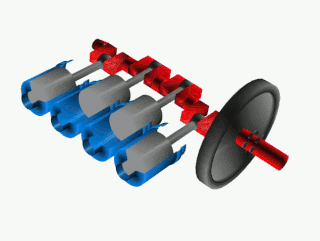 W
WA crankshaft is a shaft driven by a crank mechanism, consisting of a series of cranks and crankpins to which the connecting rods of an engine are attached. It is a mechanical part able to perform a conversion between reciprocating motion and rotational motion. In a reciprocating engine, it translates reciprocating motion of the piston into rotational motion, whereas in a reciprocating compressor, it converts the rotational motion into reciprocating motion. In order to do the conversion between two motions, the crankshaft has "crank throws" or "crankpins", additional bearing surfaces whose axis is offset from that of the crank, to which the "big ends" of the connecting rods from each cylinder attach.
 W
WThe cümbüş is a Turkish stringed instrument of relatively modern origin. It was developed in 1930 by Zeynel Abidin Cümbüş (1881–1947) as an oud-like instrument that could be heard as part of a larger ensemble.
 W
WThe cura is a plucked string folk instrument from Turkey. It is the smallest and highest pitched member of the bağlama family of instruments. It is found in nearly every region of the country with varying exact dimensions, tunings, playing techniques, and names including dede sazi, parmak cura, üç telli cura, baglama curasi, and tanbura curasi. The two other members of the bağlama family are the larger tambura and the largest divan sazi, which are one and two octaves lower than the cura, respectively.
 W
WThe Basillica or Great Turkish Bombard is a 15th-century siege cannon, specifically a super-sized bombard, which saw action in the 1807 Dardanelles Operation. It was built in 1464 by Turkish military engineer Munir Ali and modelled after the Orban bombard that was used for the Ottoman besiegers of Constantinople in 1453.
 W
WDondurma is a Turkish mastic ice cream.
 W
WA drum machine is an electronic musical instrument that creates percussion sounds, drum beats, and patterns. Drum machines may imitate drum kits or other percussion instruments, or produce unique sounds, such as synthesized electronic tones. Most modern drum machines allow users to program their own rhythms and beats. Drum machines may create sounds using analog synthesis or play prerecorded samples. Some drum machines have buttons or pads that allow the performer to play drum sounds "live", either on top of a programmed drum beat or as a standalone performance. Drum machines have a range of capabilities, which go from playing a short beat pattern in a loop, to being able to program or record complex song arrangements with changes of meter and style.
 W
WA kilij is a type of one-handed, single-edged and moderately curved scimitar used by the Timurid Empire, Mamluk Empire, Ottoman Empire, and the later Turkic Khanates of Central Asia and Eurasian steppes. These blades developed from earlier Turko-Mongol sabers that were in use in lands invaded or influenced by the Turkic peoples.
 W
WThe lavta is a plucked string music instrument from Istanbul.
 W
WMeddah is the name given to a traditional Turkish story teller, who played in front of a small group of viewers, such as a coffeehouse audience. This form of performance was especially popular in the Ottoman Empire from the 16th century onwards. The play was generally about a single topic, the meddah playing different characters, and was usually introduced by drawing attention to the moral contained in the story. The meddah would use props such as an umbrella, a handkerchief, or different headwear, to signal a change of character, and was skilled at manipulating his voice and imitating different dialects. There was no time limitation on the shows; a good meddah had the skill to adjust the story depending on interaction with the audience.
 W
WMesir Macunu is a traditional Turkish sweet believed to have therapeutic effects. Mesir paste was first produced as a medicine during the Ottoman period, but later became an important part of local festivities in the city of Manisa. Earlier versions of Mesir macunu were not sweet, but rather spicy in flavor.
 W
WA military band is a group of personnel that performs musical duties for military functions, usually for the armed forces. A typical military band consists mostly of wind and percussion instruments. The conductor of a band commonly bears the title of Bandmaster or Director of Music. Ottoman military bands are thought to be the oldest variety of military marching bands in the world, dating from the 13th century.
 W
WAltay is a Turkish modern main battle tank which is a variant of the K2 Black Panther that was developed by South Korea's Hyundai Rotem. It is named in honor of Army General Fahrettin Altay who commanded the 5th Cavalry Corps in the final stage of the Turkish War of Independence. It is one of the most expensive tank designs with a unit cost of 13.75 million dollars. Debate between Turkish military experts contend that the tank is one of indigenous Turkish origin.
 W
WThe MPT is a modular rifle family designed by MKEK and produced by MKEK, Sarsılmaz Arms and Kalekalıp to meet the demands of the Turkish Armed Forces and to replace its aging rifles such as Heckler & Koch G3 and Heckler & Koch HK33 due to most of them being near the end of their service life. The MPT was designed for robust high altitude, all weather combat, capable of functioning in extreme hot and cold weather. The MKEK MPT is a rifle intended to take abuse and extreme mistreatment and still maintain high accuracy and reliability in order to survive in true battle environments. The Turkish government has invested US$22 million into the project.
 W
WMKEK JNG-90 is a bolt-action sniper rifle that fires the 7.62×51mm NATO round used by the Turkish military. Development of the weapon first started back in 2004 to 2008. Its nickname is Bora and it is currently being offered for export.
 W
WOkey is a tile-based game, very popular in Turkey. It is almost always played by four players, although, in principle, it can be played by two or three players. It is very similar to the game Rummikub, as it is played with the same set of boards and tiles, but under a different set of rules. The game was derived from the original Rummikub after cultural contacts of Gastarbeiter in Germany. In Turkey and among Turkish communities abroad, it is very popular at cafés.
 W
WTurkish or Ottoman illumination covers non-figurative painted or drawn decorative art in books or on sheets in muraqqa or albums, as opposed to the figurative images of the Ottoman miniature. In Turkish it is called “tezhip”, meaning “ornamenting with gold”. It was a part of the Ottoman Book Arts together with the Ottoman miniature (taswir), calligraphy (hat), Islamic calligraphy, bookbinding (cilt) and paper marbling (ebru). In the Ottoman Empire, illuminated and illustrated manuscripts were commissioned by the Sultan or the administrators of the court. In Topkapi Palace, these manuscripts were created by the artists working in Nakkashane, the atelier of the miniature and illumination artists. Both religious and non-religious books could be illuminated. Also sheets for albums levha consisted of illuminated calligraphy (hat) of tughra, religious texts, verses from poems or proverbs, and purely decorative drawings.
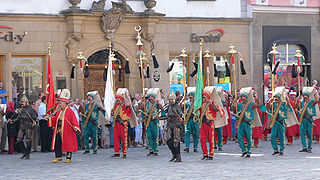 W
WOttoman military bands are thought to be the oldest variety of military marching bands in the world. Though they are often known by the word Mehter in West Europe, that word, properly speaking, refers only to a single musician in the band. In Ottoman, the band was generally known as mehterân, though those bands used in the retinue of a vizier or prince were generally known as mehterhane, the band as a whole is often termed mehter bölüğü, mehter takımı. In West Europe, the band's music is also often called Janissary music because the janissaries formed the core of the bands.
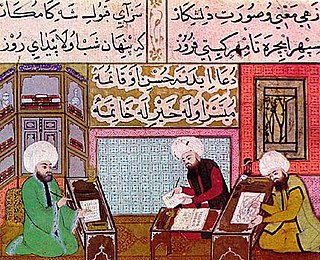 W
WOttoman miniature or Turkish miniature was a Turkish art form in the Ottoman Empire, which can be linked to the Persian miniature tradition, as well as strong Chinese artistic influences. It was a part of the Ottoman book arts, together with illumination (tezhip), calligraphy (hat), marbling paper (ebru), and bookbinding (cilt). The words taswir or nakish were used to define the art of miniature painting in Ottoman Turkish. The studios the artists worked in were called Nakkashanes.
 W
WPardus is a Linux distribution developed with support from the government of Turkey. Pardus' main focus is office-related work including use in Turkish government agencies. Despite that, Pardus ships in several languages. Its ease of use and availability free of charge has spawned numerous communities throughout the world.
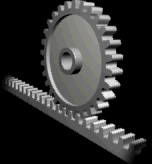 W
WA rack and pinion is a type of linear actuator that comprises a circular gear engaging a linear gear, which operate to translate rotational motion into linear motion. Driving the pinion into rotation causes the rack to be driven linearly. Driving the rack linearly will cause the pinion to be driven into a rotation. A rack and pinion drive can use both straight and helical gears. Helical gears are preferred due to their quieter operation and higher load bearing capacity. The maximum force that can be transmitted in a rack and pinion mechanism is determined by the tooth pitch and the size of the pinion.
 W
WRaki or rakı is a sweetened, often anise-flavoured, alcoholic drink that is made in Turkey and popular in Albania, Greece and other Balkan countries as an apéritif. It is often served with seafood or meze. It is comparable to several other alcoholic beverages available around the Mediterranean and the Middle East, e.g. pastis, ouzo, sambuca, arak and aguardiente.
 W
WThe Sar 109T Turkish is a small light-weight blowback 9×19 mm submachine gun manufactured by Sarsılmaz Düzce based small arms manufacturer, it was released in 2014.
 W
WA shamshir is a type of Persian/Iranian sword with a radical curve. The name is derived from the shamshīr, which means "lion's claw or lions tale" in the Persian language. The curved "scimitar" sword family includes the shamshir, kilij, talwar, pulwar and nimcha.
 W
WŞıra or sira is a Turkish non-alcoholic drink made from slightly fermented grape juice. It tastes sweet due to the high fructose it contains. Its colour is terracotta. It's mostly served with İskender kebap. A flavored version of şıra is served in the Marmara Region with the name of hardaliye. Hardaliye is basically a şıra aromatized in mustard seeds and cherry leaves for 15 days. Hardaliye is usually served in special occasions as an appetizer.
 W
WTaka is a traditional small boat, typical of the Black Sea shores of Turkey where they are primarily, but not exclusively, built and used. They can be used in fishing or for carrying small loads and a limited number of passengers. Although not very fast, they are well-balanced and resistant and are especially well-suited for the thick waves of the Black Sea. In Turkey, they are very often built by Laz people and are associated with Laz culture or with the wider Black Sea culture.
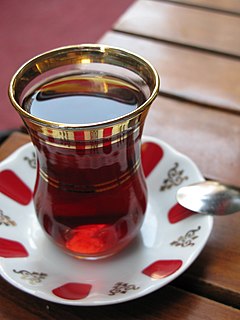 W
WTea is popular throughout Turkey and the Turkish diaspora. Turkish tea culture also extends to Northern Cyprus and some countries in the Balkan Peninsula.
 W
WA Turkish bath or hammam is a type of steam bath or a place of public bathing associated with the Islamic world. It is a prominent feature in the culture of the Muslim world and was inherited from the model of the Roman thermae. Muslim bathhouses or hammams are historically found across the Middle East, North Africa, al-Andalus, Central Asia, the Indian subcontinent, and in central and Eastern Europe under Ottoman rule. A variation on the Muslim bathhouse, the Victorian Turkish bath, became popular as a therapy, a method of cleansing, and a place for relaxation during the Victorian era, rapidly spreading through the British Empire, the United States of America, and Western Europe.
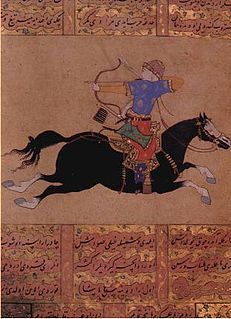 W
WTurkish archery is a tradition of archery which became highly developed in the Ottoman Empire, although its origins date back to the Eurasian Steppe in the second millennium BC.
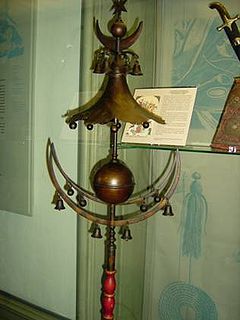 W
WA Turkish crescent, (a smaller version is called a çevgen or çağana, Turkish jingle, Jingling Johnny, Schellenbaum, chapeau chinois or pavillon chinois, is a percussion instrument traditionally used by military bands. In some contexts it also serves as a battle trophy or object of veneration.
 W
WThe tanbur is a fretted string instrument of Turkey and the former lands of the Ottoman Empire. Like the ney, the armudi kemençe and the kudüm, it constitutes one of the four instruments of the basic quartet of Turkish classical music a.k.a. Türk Sanat Müziği. Of the two variants, one is played with a plectrum and the other with a bow. The player is called a tanburî.
 W
WThe yaylı tambur is a bowed long-neck lute from Turkey. Derived from the older plucked tambur, it has a long, fretted neck and a round metal or wooden soundbox which is often covered on the front with a skin or acrylic head similar to that of a banjo.